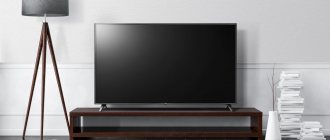What to consider when determining height?
The main task of a TV on the wall is to view it, that is, the height should be suitable for all viewers.
Therefore, first of all, evaluate - from what position do you plan to watch the programs? If this is a sofa, then you need to take into account the standard position of a person - sitting or reclining. Place the TV screen at eye level. What are the dangers of improperly installing the TV:
- Higher than necessary. The head is constantly thrown back, the neck muscles are tense. Headaches and cramps occur.
- Lower than necessary. Head down. Pain in the cervical spine and headaches may occur.
- Closer than necessary. Sitting too close means increasing the strain on the eyes several tens of times, which will lead to deterioration of vision.
- Further than necessary. You will have to constantly strain your eyesight, it will be uncomfortable, you won’t be able to see the details.
The distance from the seat to the screen is no less important than the height from the floor. Classic formula:
Screen distance = Display diagonal*2
That is, for a 48” panel (corresponding to ~122 cm), the gap is 244 cm.
Basic rules for placing a TV:
- position the display so that the center line is opposite your eyes;
- install a bracket with adjustable position if you want to watch broadcasts from different places;
- do not place the TV on the wall above appliances that emit heat (fireplace, radiator, hob);
- take into account the height of the household, the height of the furniture seats, when calculating the distance from the floor - the average value is 80-120 cm.
The TV is placed above the floor in two ways:
- On furniture. Or inside it (in a niche in a wall, slide). The method is less flexible regarding changing sizes - you need to calculate in advance at what level the niche should be located, what width and height it should be for your equipment. When placing it on top (on a chest of drawers, a nightstand, a special module), also first evaluate the recommended height, and then buy a stand.
- On the wall. Special brackets are used for hanging. A suitable model is selected according to VESA parameters, that is, the horizontal and vertical distance between the bolts must be the same on the mount, on the back panel of the TV. Brackets can be static (suitable for a clearly defined location in rooms when the TV does not need to be moved or tilted), inclined (an excellent option if you need to install the TV above a suitable level), tilt-rotate (needed for several viewing locations - in studios where one the screen should be visible from the sofa, kitchen, bed), lifting (can change direction vertically, horizontally).
Calculating the diagonal height of the TV
The screen resolution determines the optimal distance and optimal height. One value will not be enough; it is important to take into account the image resolution. You can independently calculate the recommended placement height using the formula:
Diagonal * k, where k is a coefficient equal to 2.3 for 720p, 1.6 for 1080p.
For example, to hang a 48-inch TV with 1080p quality, we use the formula: 48*1.6=76.8. This is the optimal height to the center of the screen. The only caveat is that this standard only works to determine the height of the TV in the living room; it is best suited for large panels larger than 40 inches. The larger the equipment, the higher it needs to be secured.
In order not to calculate the dimensions yourself, please refer to the table of recommendations:
| Diagonal, inches | 720p TV height to bottom, cm | 1080p TV height to bottom, cm |
| 40 | 92 | 65 |
| 43 | 99 | 70 |
| 50 | 115 | 80 |
| 55 | 127 | 88 |
| 58 | 133 | 93 |
You can check how accurately you have determined the height and range using a simple technique. Take a sheet (or several sheets) the size of your TV - attach them to the wall in the intended place, sit in front of it for a few minutes. To be convincing, you can write or draw something on paper - this way you can check the ability to read small text or examine details, for example.
Location according to the situation
The final decision on how to place the TV can be influenced not only by comfort, convenience and safety. Much depends on the situation, since the “neighborhood” of the TV with some landscaping items can lead to rapid failure of the equipment. Some situations can be cited as examples.
Above the fireplace
Regardless of the type of fireplace, the heat emanating from it can greatly reduce the service life of the equipment. In addition, sparks may fly from this heat source, which is not at all safe. Since it is unknown where they will fly. They can get inside the TV or onto significant parts of it, which will damage the equipment.
Of course, modern models of fireplaces are well insulated and comply with all fire safety standards, but it is not recommended to place a TV at a close distance above them.
The safe distance for placing the TV above the fireplace is half a meter, so nothing will threaten the equipment.
Above the battery
In rare cases, the heating battery heats up so much that it can damage the equipment. In addition, recently few people leave the elements of the heating system open; everyone tries to hide them with decorative boxes or other means.
If you leave at least half a meter between the TV and the heating source, the equipment will be safe. But, if you place the TV close to an element of the heating system, you can expect unpleasant consequences. Prolonged exposure to elevated temperatures can damage the body and screen of the TV.
Across from the window
This layout is extremely rare, but it still happens when the bed is located under the window. You can install TV equipment opposite the window opening, but it is not entirely comfortable and rational.
When daylight comes through the window, glare will appear on the screen, making it very difficult to see the full image of television broadcasts normally.
The only way out is to limit access to sunlight using blinds or thick curtains. But it is advisable to place the TV in another place, if possible.
Under the air conditioner
The air conditioner will not be able to cause any harm to the television equipment if it is properly maintained, however, everything cannot be foreseen. If the climate control device unexpectedly fails (sparks, condensation flows, etc.), and this remains not immediately noticed, then troubles cannot be avoided. If the malfunction is not corrected, it will cause irreparable damage to the TV screen.
In addition, under the air conditioner the TV does not look very aesthetically pleasing, so it is advisable not to create such a composition and, if possible, make a layout so that the equipment in the bedroom is located on different walls.
Height from floor in living room
At what height to hang a TV in the room depends on all the parameters listed above:
- living room size;
- diagonal;
- image quality;
- sofa height.
In addition, you should not forget that the whole family usually gathers in the central room of the house; viewing should be convenient from different places and angles. TV viewing time is also an important factor - the longer continuous use is expected, the more clearly you should calculate at what level to hang the TV. That is, in order to watch full-length films every evening comfortably, without straining the eyes, the position must be calculated down to the centimeter.
Before mounting the TV, decide on its distance, distance from the floor: average height 80-120 cm, distance - 2-3 TV diagonals. Depending on various parameters of TV, room, people, some deviations are acceptable.
Advice! If you are planning to install a TV in a furniture niche, first decide on the placement level. Only then order or buy a suitable model.
The installation location does not have to be determined mathematically; try to go by experience. It’s enough to listen to your feelings: sit on the sofa or chair from where you plan to watch the program. Take the most comfortable position and close your eyes. Open it, look at the wall - the bracket is hung in the place where you looked first. Every adult and small family member can do such a simple exercise, and after that the installation height is determined as the arithmetic average of the number of individual indicators.
The TV in the hall serves not only the role of a cinema. A common case is its use as a display for various consoles - PlayStation, Xbox, Nintendo. If you or your family loves to play, consider this fact before attaching the bracket. It is especially important to check the viewing angle, height, if the position of the players, the distance of the eyes from the screen differs from the usual viewing position.
Installation, useful tips
Installation of the brackets is relatively simple, as a rule, it comes down to having the skills to use a drill. Installation does not require expert knowledge or advanced tools. The most important thing is the choice of the place itself - the wall. If the walls are made of brick or concrete, installing the bracket is not a serious problem. The problem occurs when the house has walls made of soft materials, such as partitions. Then you need to consult with a specialist/seller or purchase a suitable holder with the largest possible surface area adjacent to the wall.
- Before drilling, you should draw the hole locations correctly using a suitable template, such as one supplied by the manufacturer, and use a level that will keep the line straight.
- To make the installation process even easier, some of the holder models provide alignment options even after they are screwed to the wall.
- After installing your TV, you should consider additional accessories. LED backlighting is not only an aesthetic solution, but also reduces contrast, making viewing less tiring for the eyes.
- Equally important are angled HDMI cables and special liquids for cleaning LCD screens.
- If the wall is made of plasterboard, the empty space in the wall can be used to hide cables. Another option is to run cables throughout the room in a baseboard adjacent to the wall.
At what height should you hang a TV in the bedroom?
The TV here is located opposite the bed, that is, you can watch it reclining or lying down. Depending on the arrangement of furniture and the geometry of the room, the viewing point is located at the feet (perpendicular) or to the side (parallel). The second option is less convenient, because you will have to watch while lying on one side.
When deciding at what height to hang the TV in the bedroom, be sure to take into account the angle of its inclination. To do this, use a special adjustable tilt bracket, rotate it 25-30° to the bottom - this way, even a high placement will not interfere with comfortable viewing. It is not recommended to tilt more than 30° - such a viewing angle makes the image darker, which causes discomfort when viewing - the eyes get tired faster, and vision may even deteriorate.
The brackets are suitable for all TVs, but not every matrix is designed for tilting. For example, on models with TFT the picture is distorted even with a slight rotation; you need to look at them exclusively directly.
How and at what height should I hang a TV with such a matrix? To answer the question, decide on a comfortable position in bed. Then measure the distance from the floor covering to the pupils - the resulting figure will show where the middle of the plasma window should be.
Mounting options for hanging TV
To securely place the plasma on the wall, it is important to choose the right quality fasteners. There are several options for TV brackets: rigid, inclined and universal. The first type of mount ensures that the TV is fixed in one position. The device will not be able to be rotated or bent. The TV is placed close to the wall, while ensuring a minimum ventilation gap.
For mounting TVs to the wall, inclined, rigid and universal brackets are used.
Important! When selecting a bracket with rigid fixation, there is no room for error in choosing the optimal height of the TV relative to the floor.
The tilt bracket allows you to tilt the TV vertically, while adjusting the viewing angle. This is very convenient when changing body posture while watching TV. Using the tilting bracket, you can choose a comfortable screen position when watching a program or movie while lying down, which is especially important if you place the TV in the bedroom. There will be a ventilation gap of 7-10 cm between the device and the wall.
The universal type of bracket is considered the most complex fastening option. Its special device allows you not only to tilt the TV horizontally, but also to rotate it to the right or left. This type of bracket is the most expensive in comparison with previous analogues.
Helpful advice! When the question arises of how to hang a TV in a corner, a universal bracket comes to the rescue.
Universal brackets are the most expensive, but at the same time the most optimal
The process of installing a TV on the wall is a fairly simple undertaking. To do this, you will need a hammer drill and the selected fastening element. Any model of bracket is equipped with the necessary set of fasteners to securely fix the device to the wall.
At what height should a TV hang in the kitchen?
The standard use of the receiver in the kitchen is as a background for cooking or during a lunch break. One way or another, people look at the screen itself in fits and starts, so hang the TV on the wall almost any way you like.
In the dining area, the preferred location is above the table, at a level of 1.2-1.5 meters from the floor. In the work area - above the refrigerator or in any free area. Consider unsuitable proximity:
- It is considered unacceptable to place near heating devices (cooking, oven), wet areas (sink);
- Because of the sun's glare, it is equally uncomfortable to watch a TV located on a wall with a window opening or opposite it.
When calculating at what distance from the floor to hang the TV in the kitchen, analyze your habits. If you watch it more often while cooking, calculate the level based on your standing height. Are you used to learning the latest news over a cup of coffee? Set at eye level while sitting.
A tilt-and-swivel bracket would be useful for the kitchen - then you can use the TV while standing at the stove or sitting on a chair at the dining table. The panel is installed at the highest suitable point, and in order to look from below, it is simply tilted. The main thing is to position it in such a way as to prevent injury when the panel is tilted.
Determining the height in the children's room
Whether a child even needs his own TV in an apartment, whether it is harmful or useful, is a controversial issue. Children who are too active while playing ball can injure themselves or drop the LCD. If you are determined to install an LCD, first of all, correctly determine at what height on the wall to hang the TV.
- Firstly, like everything for children, height should be determined based on growth. This is especially true during the active growth phase, otherwise the panel will have to be re-hanged every year.
- Secondly, answer yourself the question: for what purpose is the TV installed. Playing a console is one thing, watching before bed is another.
Rules for placing the TV in the nursery:
- the position of the lower part should be higher than the child’s height to prevent impacts during games;
- Preferably the use of static brackets that do not allow the child to move or tilt the TV in order to avoid damage.
Children usually watch TV while playing or doing other activities, so it is difficult to determine the main position. Hang the bracket opposite one of the main sitting places (bed, sofa) - and the baby will figure out other options on his own.
In the case of determining a place for a TV, the saying “Measure seven times, cut once” is especially relevant. To avoid damaging the wall with extra holes, check your calculations and only then begin installation.











